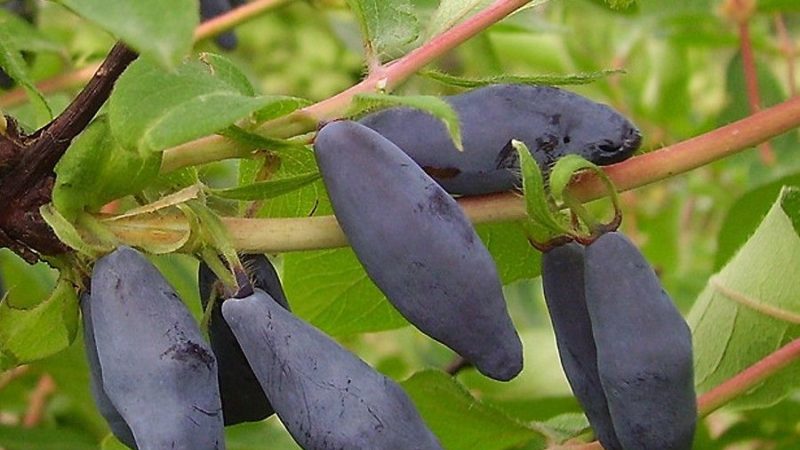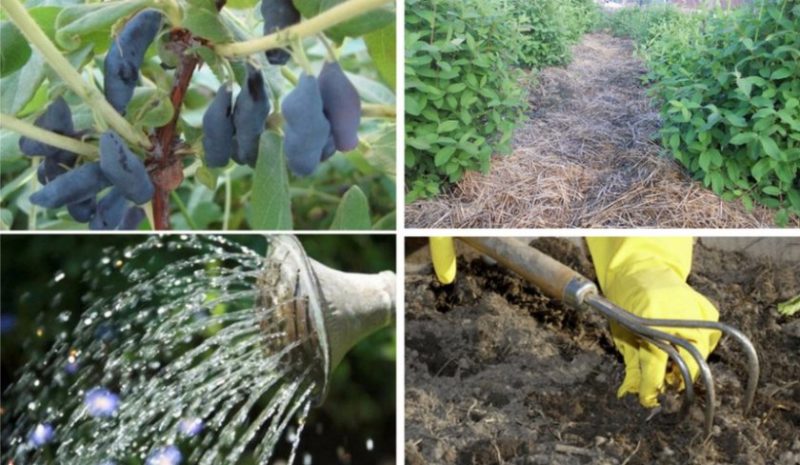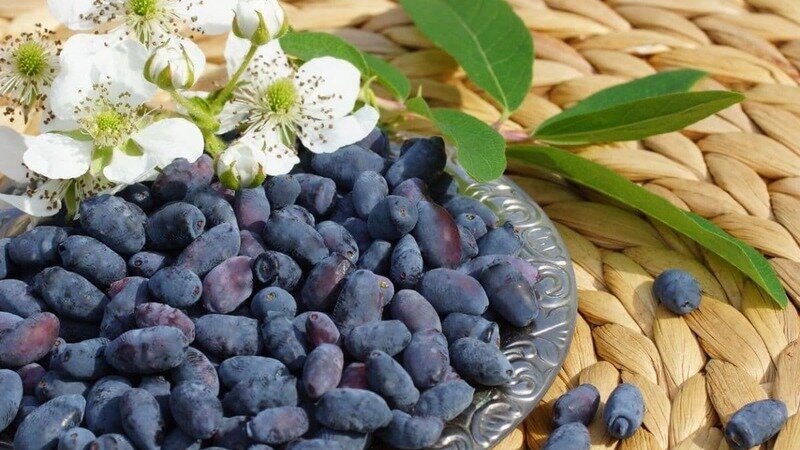Unpretentious in cultivation variety of honeysuckle Blue Bird
Bluebird is an edible honeysuckle variety suitable for growing in northern regions. Among its positive characteristics, unpretentious care and the ability to adapt to various climatic conditions are noted. Let us consider in detail the rules for planting and growing the Blue Bird, the agrotechnical requirements of the variety.
The content of the article
Description of the variety of honeysuckle Blue bird
Honeysuckle Blue bird - the result of the work of domestic breeders. The fruits contain 6.4% sugars, 17 mg of ascorbic acid and 631 mg of P-active substances.

Origin and development
The variety was bred in the Siberian Research Institute of Horticulture named after I. MA Lisavenko as a result of spontaneous mutation caused by the cross-pollination of Kamchatka honeysuckle.
Reference. In specialized nurseries, this plant is sometimes found under the name "2-24".
Specifications
A vigorous shrub (height - 1.2-1.4 m, with proper care - 2 m) with a dense ellipsoidal crown with a diameter of 1.7-1.8 m. Shoots are thin, not pubescent, the bark on young branches is light green, on last year's - brick-brown. The leaf plates are oval, with sharp ends, green, smooth and shiny.
The flowering period begins immediately after frost. At this time, small bell-shaped flowers of a yellowish hue appear on the bushes, located in the leaf sinuses of 2 pieces.
Fusiform berries reach a length of 2 cm, weigh 0.75–0.8 g each, are covered with a thin ink-violet skin with a bluish-gray bloom. The taste is sour-sweet, slightly tart, with a pleasant fruity aroma.
Application features
Berries are consumed fresh and used for processing: making jams, jams, marshmallows, confitures and compotes.
Ripening period, yield and fruiting
This is an early ripening variety of honeysuckle - the harvest is ready for harvest in early June. Bushes bear fruit within 20-25 years, starting from 3 years after planting. Average yield is 1–1.5 kg per plant. With proper care and favorable climatic conditions, bushes aged 6–8 years produce 2.5–3 kg of berries.
Disease and pest resistance
The variety is characterized by high immunity to pests, but if the rules of care are violated, the Bluebird honeysuckle infects powdery mildew, mites and aphids.
Cold and drought resistant
Bushes tolerate a drop in air temperature to -40 ... -45 ° C without additional shelter, but they react negatively to sudden seasonal temperature changes, for example, a winter thaw.
The culture does not tolerate prolonged drought, and the boggy soil provokes rotting of the root system. Optimum humidity level soil — 50–60%.
Which regions is best suited for
The variety is recommended for growing in the Northwest region. Due to its hardiness and the ability to quickly adapt to different climatic conditions, the Bluebird is successfully cultivated in all areas.
Advantages and disadvantages of the variety
The main advantages of the Bluebird:
- frost resistance;
- immunity to diseases and pests;
- unpretentious care;
- the ability to adapt to different climatic conditions;
- long period of fruiting;
- universal use of berries;
- early ripening of the crop.
Cons of the variety:
- the need for pollinating varieties;
- sensitivity to temperature changes;
- exactingness to the level of soil moisture;
- relatively low yield.
Differences from other varieties and hybrids
Comparison of Bluebird with other early maturing varieties of honeysuckle:
| Variety | Berry weight, g | Taste | Berry shape | Productivity, kg / bush |
| Blue bird | 0,75–0,8 | Sour sweet | Fusiform | 1–1,5 |
| Amazon | 1,1 | Sweet and sour, with a slight bitterness | Jug-shaped | Up to 1.5 |
| Baikal | 1 | Sweet | Oblong | 1,5–2,5 |
| Viola | 1 | Sweet and sour, with bitterness | Elongated | 1,9–3 |
Agrotechnics
In order for the Bluebird bushes to give a stable harvest for many years, it is important to observe their timing landing, choose a suitable place and provide the plants with proper care.
Choosing a place in the garden
For planting honeysuckle, they choose an illuminated place, protected by trees or buildings from the cold gusty wind. The permissible depth of groundwater is at least 1.5 m.
Due to the intolerance of waterlogging of the soil, the crop is not planted in lowlands and in wetlands.
Preparing for landing
It is advisable to buy 2-year-old seedlings 25–60 cm high with a closed root system and many thin white root processes visible on the surface of an earthen coma.
24 hours before planting in the ground, the seedlings are removed from the container, the rhizome is cleaned from the ground, washed under running water and all dry parts of the plant are removed. After that, the roots are soaked for 18–20 hours in a solution of a growth stimulator (40 drops of "Zircon" per 1 liter of water).
Reference. In the case of planting honeysuckle, sand is not added to the sandy loam soil.
Since the fall, the site is dug to a depth of 40 cm and spilled with a solution of copper sulfate (1 liter per 10 m²) for disinfection. After 7-10 days, 20 kg of manure, 400 g of wood ash and 10 kg of sand are applied for each 1 m² of soil, and the soil is re-digged to a depth of 20 cm.
Ground requirements
The highest yields are observed when the Bluebird is grown in light, loose and fertile soil with good aeration, moisture permeability and acidity within the pH range of 5–7. The best option is loam and sandstone.
Timing, scheme and landing rules
The optimal planting time for Bluebird is late summer, 1–1.5 months after harvest. In the southern regions, it is allowed to plant bushes in mid - late September.

Landing rules:
- 20 days before planting, in the prepared area, dig holes 40 × 40 cm in size so that there is a pollinator plant in the center, and Bluebird bushes around it.
- Fill 1/3 each hole with nutritious soil mixture (half of the excavated soil, 20 kg of compost and 1.5 kg of wood ash).
- Form hills of soil mixture in the center of the pits about 10 cm high.
- Cover the holes with plastic or tarp.
- After 20 days, remove the shelter, pour 5 liters of water into each hole.
- When the moisture is absorbed, make a depression in the center of the hill and place the roots of the seedling in it, spreading them over the entire area.
- Cover the voids with earth so that the root collar is flush with the ground.
- Tamp and water the soil in the trunk circle, spending 7-10 liters of water for each plant.
- Cover the trunk circle with compost.
The minimum distance between plants is 1.5 m.
Growing features

The frequency of watering depends on climatic conditions: in hot weather, honeysuckle is moistened every 3-4 days, pouring 10-15 liters of water under the root of the bush. If it rains frequently, the amount of watering is reduced.
After moistening, the soil in the trunk circle is loosened to a maximum depth of 5 cm in order to improve its moisture and air permeability, and mulched with compost.
Feed the bushes start 3 years after planting according to the scheme:
- in spring, before the buds swell - with a urea solution (10 g of substance per 10 liters of water) at the rate of 3 liters for each bush;
- 10 days after flowering - wood ash (300 g per bush);
- 14 days after harvest - with a nutrient solution (30 g of superphosphate and 20 g of potassium sulfate per 10 l of water).
Every 3-4 years, the urea solution is replaced with organic matter in the spring: 15–20 kg of rotted manure per plant trunk circle.
They begin to cut off the bushes at 4-5 years of age. All branches thickening the crown are removed, leaving only hemp 20–40 cm long, so that there are a maximum of 15–18 strong shoots on the bush. A third of the skeletal branches are left intact, the rest are cut off the highest lateral shoot.
Important! The procedure is carried out in spring or autumn. Most importantly, the air temperature must be above 0 ° C.
When the bushes reach the age of 12-15 years, they carry out anti-aging pruning - they get rid of 3-5 non-fruiting shoots per season.
Pollinators
It is a self-infertile variety that requires suitable pollinator varieties for fruiting:
- Cinderella;
- Moraine;
- Titmouse;
- Kamchadalka;
- Start;
- Blue spindle.
Disease and pest control

Diseases and pests affecting the Bluebird:
| Disease / pest | Signs | Treatment |
| Powdery mildew | Curvature of leaves, the appearance of a whitish bloom on them. | The infected parts of the plants are removed, the bushes are treated with Fitosporin. |
| Mites | Yellowing and falling foliage, the appearance of a thin white web on plants. | The affected areas of the bushes are removed, the soil is loosened to a depth of 5 cm. Plants and soil are powdered with tobacco dust and sprayed with "Fitoverm". |
| Aphid | The appearance of a sticky bloom on the shoots, curling and deformation of the leaves. |
To prevent the development of diseases and pest attacks at the beginning or end of the season, the bushes are sprayed with a solution of Bordeaux liquid, and during active growing season, the soil and foliage are powdered with wood ash once every 10 days.
Preparing for winter
In mid-September or October (depending on the climatic conditions of the region), water-charging irrigation is carried out - 30-40 liters of water are poured under each bush. After that, the trunk circle is loosened, mulched with compost and peat, mixed in equal proportions. The height of the mulch layer is 10 cm.
Reproduction

Honeysuckle Bluebird multiply vegetatively:
- Green cuttings. After flowering bushes, cuttings 12 cm long are cut from young shoots so that each has 3 buds. For a day, they are soaked in a growth stimulant solution ("Kornevin", "Heteroauxine"), planted in the ground and covered with plastic bottles or polyethylene, regularly watering and airing.
- Lignified cuttings. From the shoots of the current year, on which there are 2–5 internodes, in late September - early October, after the foliage has fallen off, cuttings are cut, wrapped in burlap or paper, dropped to a depth of 10 cm and covered with foliage. In the spring, they are planted in the ground at an angle of 45 ° so that 1 internode remains above the surface.
- By dividing the bush... Before the buds swell or after the foliage has fallen off, the bushes at the age of 3-5 years are dug out, divided into several parts with a pruner, and each is planted in a permanent place.
Possible growing difficulties
Problems with Bluebird cultivation:
- shedding of unripe berries - the bushes do not have enough moisture;
- slow development of bushes, cessation of fruiting - planting in lowlands or excessive watering, which caused swampy soil;
- curvature of leaf plates, the appearance of a whitish coating on them are signs of powdery mildew.
Harvesting
When the berries begin to darken, a film or cloth is spread under the bushes to preserve the crumbling part of the crop. About 15 days after this, the plants are shaken to collect the fruits remaining on the branches.
The berries are sorted, getting rid of all damaged specimens. Whole, without signs of disease or damage, the fruits are placed in shallow containers lined with paper and stored in the refrigerator for a maximum of 3 days.

Advice and feedback from experienced gardeners
Gardeners recommend:
- have 3 varieties of honeysuckle on the site at once and, if possible, organize planting of 10-15 bushes - this will have a positive effect on the size and taste of the berries;
- in order to attract insects carrying pollen to the site during the flowering period, spray the leaves and the outside of the buds with honey syrup (40 g per 10 l of water).
Farmers speak positively about the variety.
Irina, Volgograd: “This is not the most productive variety, but we have enough berries. Initially, they planted bushes to make a hedge, but because of their self-fruitlessness, the idea did not work out - they abandoned it and grow bushes in groups. The fruits are very tasty both fresh and processed. For all the time the plants have never been ill with anything. "
Mikhail, Belgorod: “For prophylaxis, I process honeysuckle at the same time as other plants, so during the entire period of growing the Blue Bird, I have not encountered the fact that the bushes get sick or are attacked by pests. I like that the variety bears fruit steadily and for a long time, the berries ripen early, they are very tasty. "
Conclusion
The honeysuckle variety Blue Bird was bred by domestic breeders and is characterized by a high degree of resistance to frost, diseases and pests, unpretentious care, early ripening of berries and their universal use. Among the shortcomings of the plant, self-infertility, sensitivity to temperature changes and low productivity are noted.